Treak Cliff Cavern
Useful Information
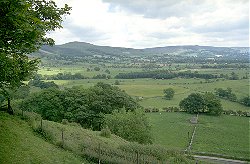
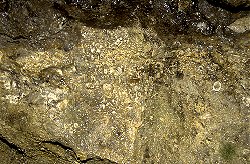
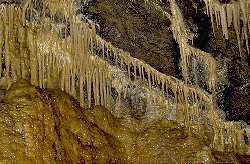
| Location: |
At the end of Hope Valley, 2 km west of Castleton, Peak District.
25 km from Sheffield, 45 km from Manchester. (53.344571, -1.797610) |
| Open: |
07-FEB to 23-NOV daily 10-17, last tour 16:15. 24-NOV to 06-FEB Mon-Fri 11, 15, Sat, Sun 10-15:20 Closed 24-DEC, 25-DEC, 26-DEC, 31-DEC, 01-JAN. [2008] |
| Fee: |
Adults GBP 7, Children GBP 3.60, Family GBP 19, Student GBP 6, YHA GBP 6, Senior GBP 6. Parking 1 hour 80p, over 5 hours GBP 3. [2008] |
| Classification: |
 Karst Cave Karst Cave
 Gem Mine,
Blue John formations. Gem Mine,
Blue John formations.
|
| Light: |
 Incandescent Incandescent
|
| Dimension: | L=215m |
| Guided tours: | L=150 m, D=20 min. V=82,000/a [2000] |
| Photography: | |
| Accessibility: | |
| Bibliography: |
Trevor C Ford (1992):
Treak Cliff Cavern and The Story of Blue John,
with a Foreword by Peter C Harrison. 1992. 24 pp.
Numerous colour plates and diagrams. Discovery, Tour of the Cavern, Rocks, Minerals etc. |
| Address: |
Treak Cliff Cavern, Castleton, Derbyshire S33 8WP. Tel: +44-1433-620571.
E-Mail: |
| As far as we know this information was accurate when it was published (see years in brackets), but may have changed since then. Please check rates and details directly with the companies in question if you need more recent info. |
|
History
| 1745/50 | older series of chambers discovered. |
| 1800 | part of the caverns opened to the public. |
| 1843 | public parts improved and extended. |
| During WWI | flourspar was used as a flux in blast furnaces and in the chemical industry. |
| 1923 | a small cave close to the surface was discovered, containing the remains of two bronze age humans. |
| 1926 | new series of chambers discovered. |
| 1932 | alternative route to the new series discovered. |
| 1934 | paths and lighting installed. |
| 1935 | opened to the public. |
Description
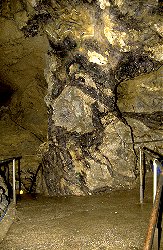
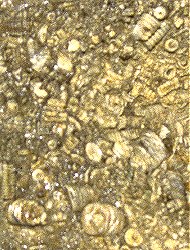
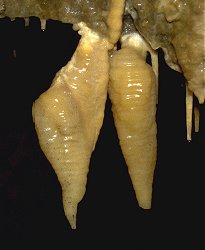

Treak Cliff Cavern is one of the places where Blue John, a blue or purple Fluorite is found. Nearby Odin Mine is the place where this mineral was first mined. But here was one of the richest deposits, and it was very close to the surface.
The first part of the cave is mainly artificial, being the remains of a Blue John mining operation. However, even in this part of the tour there are many small natural caverns which saved a lot of time during mining. Some caverns were opened to the public as early as 1800. During the mining in 1926, additional chambers were discovered, which are deeper inside the mountain and have a much different character. There is no Blue John, but this part is very stable and shows many nice speleothems. It was developed with paths and light in 1934, and 1935 the cave was opened to the public as it is today.
Another feature of the cave is the beautiful view down the Hope valley to Castleton. And this sight is for free!
Treak Cliff consists of two distinct series of caverns. The outer series was discovered by lead miners in the eighteenth century, and contains some attractive beds of the semiprecious mineral, Blue John. The inner series, discovered in 1926, contains one of the best displays of stalactites in Castleton. It is called Aladdin’s Cave. From this chamber a passage leads into Fairyland, a circular chamber containing a series of stalactites looking very much like carrots seen from below ground.
From Fairyland, the passage leads into the Dream Cave. Here, many of the formations have been given names. There is the Elephant, the Crucifix, and many more besides. The longest stalactite here is nearly four feet in length and underneath it is a stalagmite about a foot high, only 1.5 inches away from it. It will take over a thousand years at the present rate of growth before they join up. The next chamber is called the Dome of St. Pauls; nearly 40 feet high, it presents a fascinating spectacle of colours in the stalactite draperies adorning the walls.
The return to the surface takes us back through Fairyland, and out of an upper exit, which commands a fine view of the Hope Vailey.
Text from: Tony and Anne Oldham (1972): Discovering Caves - A guide to the Show Caves of Britain. With kind permission by Tony Oldham.
- See also
 Search DuckDuckGo for "Treak Cliff Cavern"
Search DuckDuckGo for "Treak Cliff Cavern" Google Earth Placemark
Google Earth Placemark Treak Cliff Cavern - Wikipedia (visited: 23-SEP-2010)
Treak Cliff Cavern - Wikipedia (visited: 23-SEP-2010) Treak Cliff Cavern - The Home of Blue John Stone, official website.
Treak Cliff Cavern - The Home of Blue John Stone, official website. Treak Cliff Cavern (visited: 23-SEP-2010)
Treak Cliff Cavern (visited: 23-SEP-2010) Castleton - Treak Cliff Cavern (visited: 23-SEP-2010)
Castleton - Treak Cliff Cavern (visited: 23-SEP-2010) Treak Cliff Cavern, Mam Tor, Castleton, Hope Valley, England (visited: 23-SEP-2010)
Treak Cliff Cavern, Mam Tor, Castleton, Hope Valley, England (visited: 23-SEP-2010) Treak Cliff Cavern - Visit Peak District - E&A Details (visited: 23-SEP-2010)
Treak Cliff Cavern - Visit Peak District - E&A Details (visited: 23-SEP-2010) English Industrial Sites - Treak Cliff Caverns (visited: 23-SEP-2010)
English Industrial Sites - Treak Cliff Caverns (visited: 23-SEP-2010)
 Index
Index Topics
Topics Hierarchical
Hierarchical Countries
Countries Maps
Maps